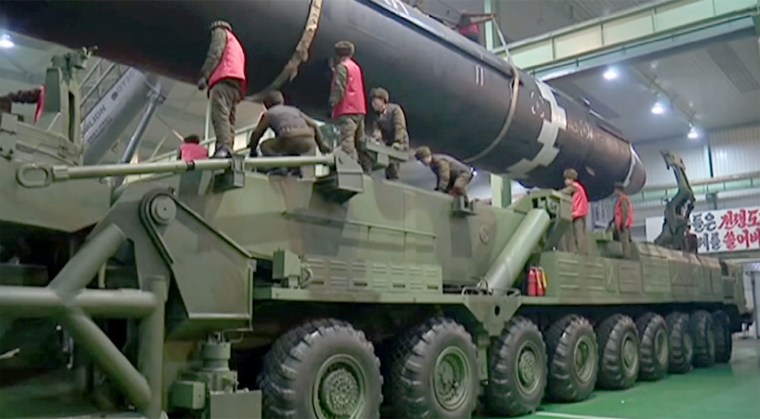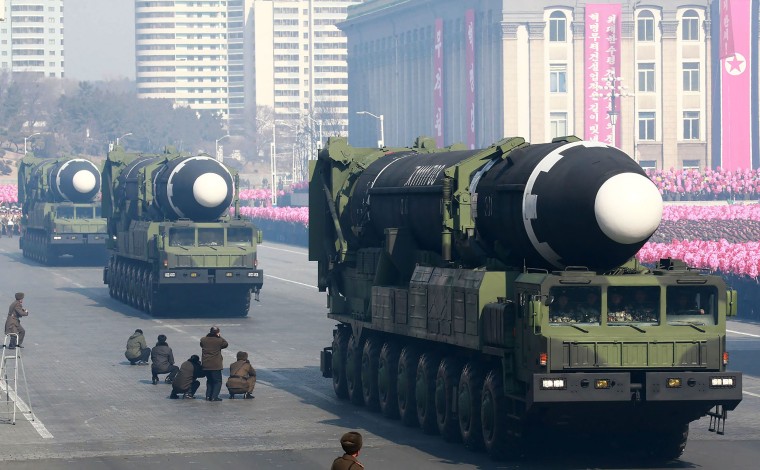MONTEREY, Calif. — What appears mundane to the untrained eye can offer surprising insights to the independent analysts tracking North Korea's military capabilities.
The flow of information out of the country is notoriously thin, so experts often turn to open-source material for clues. That’s especially true for those operating outside government in the so-called parallel intelligence community.
Jeffrey Lewis and his team at the Middlebury Institute of International Studies here have spent years studying satellite imagery, military parades and propaganda hoping to glean revealing tidbits and understand the latest developments in North Korea.
For example, the serial number of a missile-bearing crane recently helped Lewis to deduce a weapon's range — leading him to believe it could likely hit the mainland U.S.

A photo released by North Korea showing its most advanced intercontinental ballistic missile allowed Lewis’ team to identify the crane's manufacturer and its model. Searching online, they found the crane’s length and load capacity — which allowed them to infer the missile’s weight and range.
Kim Jong Un's regime tested that missile in November. Had it been fired at a lower angle, some experts believe that it may have had a range of 8,100 miles, placing the continental U.S. within reach.
Pyongyang’s own videos also allow Lewis to measure any launched missile's size and speed — two variables that reveal the power of its engine. From there they model the missile’s performance, so even if launched vertically, they can project whether it could potentially reach New York or Los Angeles.
Lewis’ team has also poked holes in North Korean claims of prowess. A video released in January 2016 purporting to show a successful missile launch via submarine was actually two different launch videos spliced together. The submarine launch was really a failure: The missile exploded after ignition. But the official video cut to footage from a successful Scud missile launch from June 2014 and claimed success.
However, open-source analysis has its limits.
“The intelligence community has access to the best satellites in the world from radar to thermal to multi-spectral,” explained Joseph S. Bermudez Jr., a senior analyst at 38 North, a project affiliated with Johns Hopkins University that analyzes North Korea. Government officials also have access to signals intelligence and sources around the world.
“You’re talking about hundreds of thousands of people in the intelligence community working on an issue, as opposed to half a dozen," Bermudez said. "There’s a level of difference.”
In September, North Korea conducted its sixth nuclear test and its first of a miniaturized hydrogen bomb, intended for a long-range missile.
Mounting a nuclear warhead on a long-range ICBM is North Korea's next challenge. But Lewis says it’s a question of when, not if, Pyongyang will get there.
He believes only a “time machine” could stop North Korea from developing the ability to strike America with a nuclear weapon.
“There is no country that's been able to build an intercontinental ballistic missile that hasn't been able to figure out the rest of it," Lewis said.
Talk of a preventive strike is useless given how far the regime has already come, he says.
For Lewis, the only viable option for the U.S. and its allies is to accept a nuclear-armed North Korea and focus instead on shared interests: averting nuclear war. That means reducing tension on the peninsula — admittedly a difficult task, given that North Korea is “not the world’s greatest neighbor.”
Lewis' view is at odds with that of National Security Adviser H.R. McMaster, who said in December that the U.S. “can’t tolerate the risk” of a nuclear-armed Pyongyang. “Accept and deter is unacceptable,” he has said, with denuclearization still the policy objective of the U.S.

North Korea has said in public statements that it wants an official end to the Korean War. The conflict was halted by a 1953 armistice but no peace treaty was ever signed. It also wants nothing short of full normalization of relations with the U.S. and to be treated with respect and as an equal in the global arena.
Kim fears the U.S.-led regime change that felled Moammar Gadhafi in Libya and Saddam Hussein in Iraq, Lewis argues. That makes the nuclear program a safeguard against being overthrown and a priority with existential implications in Kim’s eyes.
To Lewis, the best the U.S. can hope for is if a nuclear-armed North Korea wants to be left alone. A much worse scenario is an emboldened, aggressive regime that sinks South Korean ships and shells Japanese islands.
What remains to be seen is how the U.S. will react once North Korea tests a long-range ICBM at range — a necessary step before it can credibly claim to be able to hit the U.S. with a nuclear weapon.
Despite President Donald Trump’s threat to rain “fire and fury” on North Korea, Lewis believes that the costs of nuclear war — millions of fatalities — will stop the administration from reaching that point.
"As unpleasant as it is and as bizarre as this government is, you have to find a way to live with each other,” Lewis said.
Richard Engel reported from Monterey, and Kennett Werner from London.
